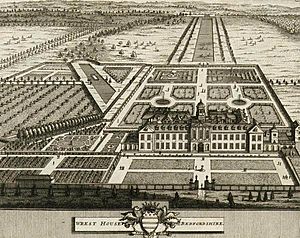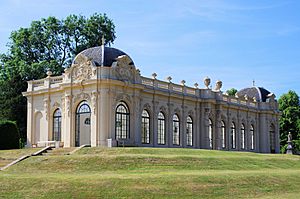Wrest Park facts for kids
Quick facts for kids Wrest Park |
|
|---|---|
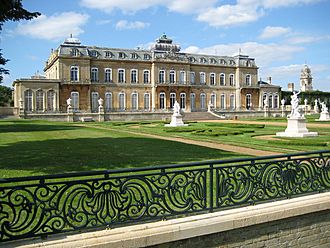
Wrest House, from the south
|
|
| General information | |
| Type | Country estate |
| Location | Silsoe, Bedfordshire |
| Country | England |
| Coordinates | 52°00′29″N 0°24′44″W / 52.0080°N 0.4121°W |
Wrest Park is a large country estate located in Silsoe, Bedfordshire, England. It includes Wrest Park House, a very important country house, and Wrest Park Gardens. Both the house and gardens are listed as Grade I buildings, meaning they are of exceptional historical interest.
Contents
History of Wrest Park
Building the New House
The original house at Wrest Park was described in a poem by Thomas Carew in 1639. This old house was taken down between 1834 and 1840.
The current house was built from 1834 to 1839. It was designed by its owner, Thomas de Grey, 2nd Earl de Grey. He was an amateur architect and the first president of the Royal Institute of British Architects. He got his ideas from buildings he saw during trips to Paris. He used designs from French architecture books to create the house.
The inside of Wrest Park has some of the earliest Rococo Revival designs in England. This style is known for its fancy and playful decorations. Some of the main rooms in the house are open for people to visit today.
Wrest Park in the 20th Century
During World War I, Nan Ino Cooper, 10th Baroness Lucas used Wrest Park as a military hospital. However, a fire in September 1916 stopped this use. After her brother passed away, she inherited the house and sold it in 1918.
A man named Mr. J.G. Murray bought it. He was involved with cricket in Bedfordshire. During the 18 years he owned it, many of the garden statues were sold. Also, many old trees in the park and garden were cut down.
In 1939, Sun Alliance Insurance bought Wrest Park. After the Second World War, it became a research center for modern farming engineering.
English Heritage took over the house and gardens in 2006. They started a 20-year project to bring the gardens back to how they looked before 1917.
Wrest Park Gardens
Wrest Park has a very old garden, covering about 92 acres (37 hectares). It was likely first designed in the early 1700s by George London and Henry Wise. Later, Lancelot "Capability" Brown changed parts of it to a more natural style.
The park has a wide gravel path in the middle. This path continues as a long canal that leads to a beautiful Baroque pavilion. This pavilion was designed by Thomas Archer and finished in 1711. The inside of the pavilion has impressive Ionic columns painted to look real (this is called trompe-l’œil).
Capability Brown worked on the gardens between 1758 and 1760. He changed the straight boundary canals to have a more natural shape. He also added a canal and woodland around the main formal area. Other features like an orangery and marble fountains were added later. A building called the Bathhouse was built between 1769 and 1772.
In 1736, Horace Walpole visited Wrest Park. He saw monuments in the garden that remembered the Duke of Kent’s children. There was also a monument for the Duke himself, even though he was still alive.
A giant Wellingtonia tree was planted in 1856. In its early years, this tree was brought into the house every Christmas to be a Christmas tree. This is one of the earliest known examples of a Christmas tree in the UK.
Restoring Wrest Park
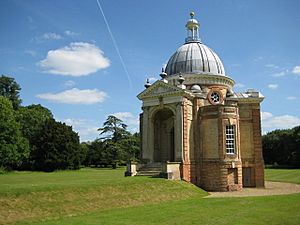
In 2007, English Heritage announced that the Wolfson Foundation would give up to £400,000 for restoration work. This money helped fix the main entrance, garden statues, railings, and gates. Future plans include restoring the lakes and canals.
On September 12, 2008, English Heritage shared big plans to restore Wrest Park house and gardens. They wanted to bring them back to their original beauty. In 2008, the music video for "The Fear" by Lily Allen showed scenes inside and outside Wrest Park.
In July 2010, English Heritage announced they received over £1 million from the Heritage Lottery Fund. This money was used to build a new visitors center, car parking, exhibition space, and accessible paths. The work was finished in summer 2011, and the park opened to the public on August 4, 2011.
English Heritage and Historic England have done a lot of research on the gardens as part of the restoration. This includes archaeological and geophysical surveys. For example, they removed an overgrown yew hedge. Maps showed this hedge existed in 1717. They studied the wood from the trees to see if they were original. They found the wood dated to 1780–1800.
Capability Brown Memorial
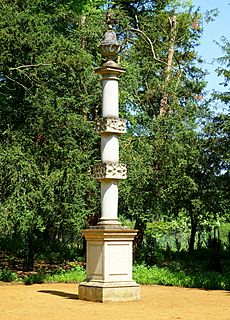
There is a memorial column dedicated to Lancelot "Capability" Brown. It was first placed near the Bowling Green House, which was changed by Batty Langley in 1735. Now, it is in the eastern part of the gardens. The column has an inscription that says: "These gardens, originally laid out by Henry Duke of Kent, were altered by Philip Earl of Hardwicke and Jemima, Marchioness Grey with the professional assistance of Lancelot Brown Esq. in the years 1758, 1759, 1760."
Wrest Park in Media
Wrest Park has been used as a filming location for several projects:
- The house was used in the music video for the 2008 song "The Fear" by Lily Allen.
- In August 2013, the park hosted a concert by the rock band Status Quo.
- The opening scenes for "The People's Strictly for Comic Relief," a special series of Strictly Come Dancing in 2015, were filmed at Wrest Park.
- A 2016 episode of BBC's Flog It! was filmed at the park.
Images for kids
See also
 In Spanish: Wrest Park para niños
In Spanish: Wrest Park para niños


